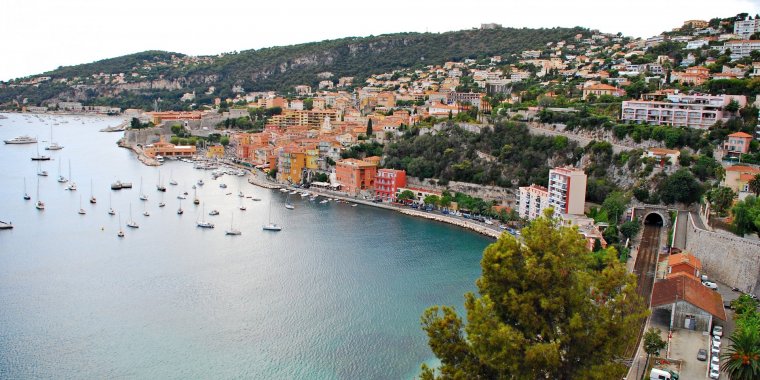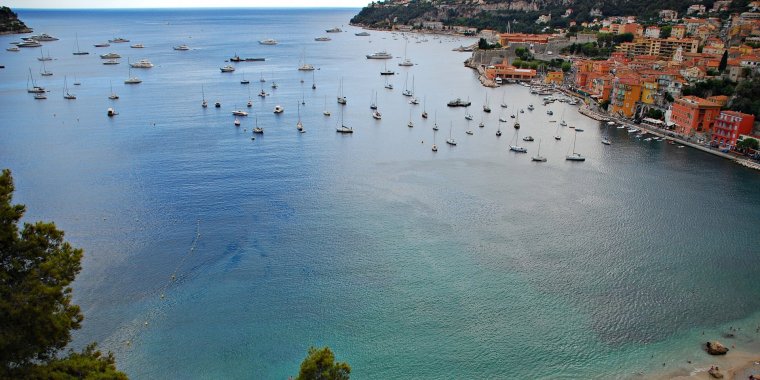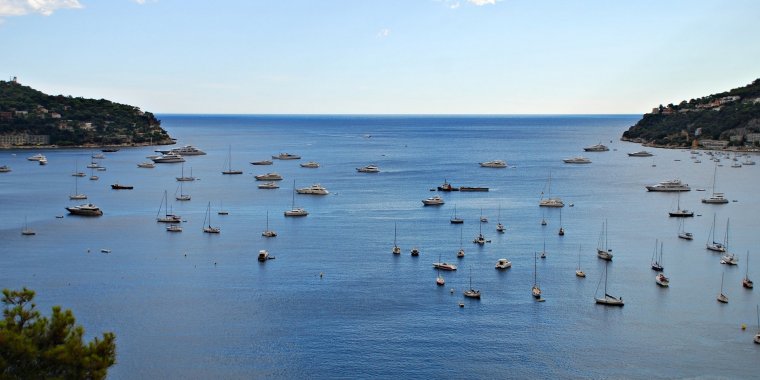| Published in Destinations |
Villefranche-sur-Mer, France

Villefranche-sur-Mer. Photo: Cătălin Kislinger / Titi Tudorancea Bulletin.
Villefranche-sur-Mer is a small beach resort and residential town (popn 30,000) on the French Riviera. The deep water harbour is home to Mediterranean cruise boats, whose tenders routinely disgorge several thousand passengers on organised trips to nearby Eze Village and Monaco. It sports excellent restaurants and a coarse sandy beach much favoured over Nice's stony bay.
Convenient harbour car parking attracts visitors from Monaco and along the Riviera. The Citadelle st Elme dates back to antiquity and the town offers easy access to the millionaires peninsula of St Jean Cap Ferrat.
Villefranche-sur-Mer adjoins the city of Nice to the east along Mont Boron, Mont Alban and Mont Vinaigrier, and 10 km (6.2 mi) south west of Monaco.
The bay (rade) of Villefranche is one of the deepest natural harbours of any port in the Mediterranean Sea and provides safe anchorage for large ships, reaching depths of 95 m (320 ft) between the Cape of Nice and Cap Ferrat; it extends to the south to form a 500 m (1700 ft) abyss known as the undersea Canyon of Villefranche at about one nautical mile off the coastline.
The town limits extend to the hills surrounding the bay climbing from sea level to an altitude of 520 m (1750 ft) at Mont-Leuze, reflecting on land the features found offshore. The three "Corniches" or main roads linking Nice to Italy pass through Villefranche.
Villefranche's bay is notable for reaching a significant depth only a short distance from shore. As a result, it has become an important port over the years. Since the 1980s Villefranche has been used by cruise ships. It is the most visited cruise ship port of call in France.
What to see in Villefranche-sur-Mer
• Église Saint-Michel (Saint Michael's Church) in the heart of old town, was built in the 1750s in the baroque Italian-style where originally stood a more modest early fourteenth century church. It houses various works of art, notably a large Saint Michael painting above the marble main altar, a recumbent sculpture Christ (18th century) known as the "Christ of the Galleys" and a polychrome wooden statue of San Rocco.
The organ built by the Grinda Brothers in 1790 is one of the oldest of the County of Nice still in operation. The building was included in the French Historic Sites Registry in 1990.
• The Chapelle Saint-Pierre (Saint Peter's Chapel) dates from the sixteenth century. Used as a storeroom for local fishermen's nets and equipment for most of the 19th and early part of the 20th century, it was restored in 1957 with Jean Cocteau adding his now-famous murals depicting the life of the saint and of local fishermen. The building was included in the French Historic Sites Registry in 1995.
• The old harbour of la Darse dates back to the 17th century. Built originally for the galleys of the Duke of Savoy, it is now a marina with dockyard activities for yachts. It is also the site of the oceanographic observatory Observatoire Oceanologique de Villefranche of the Pierre and Marie Curie University of Paris and of the French National Centre for Scientific Research with 3 laboratories (oceanology, marine geoscience and cell biology) and 150 personnels attached to it. Buildings and structures surrounding the harbour are also included in the French Historic Sites Registry since 1991.
• The Citadel built in 1557 now houses the Town Hall, a convention centre, three museums and an open-air theatre.
• The Rue Obscure (Dark Street)” is a passageway under the harbour front houses which dates back to 1260.
• The Villa Léopolda on the hills surrounding was once the residence of King Leopold II of Belgium and has been tagged as “the most expensive house in the world”.
• The Beach Villefranche (Plage des Marinières) is a great day trip from Nice because of its proximity, size and beach. It's still not a fine sand, but much better than the smooth stones that make up Nice's beaches.
Additionally, because the town is quite small, there are next to no tourists clogging up the quaint, waterfront town. With this said the beach is very busy in the high season and very narrow so space is limited. It stretches for 1 km under the track of the railway line linking Nice to Italy.
• Plage de la Darse is a smaller pebble beach located behind the main jetty of the harbour of La Darse.
Get in
• The route by car from the Basse Corniche down to the old town and waterfront is very tricky in the high season due to the narrow streets and heavy traffic, coaches etc. When you arrive you will also find it difficult and expensive to park. The best way to get to Villefranche is by taking a TER train. They run along the coastal towns between Nice and Monaco, making several stops along the way.
Tickets are very cheap (for an adult from Nice to Villefranche is 1.60 Euro) and can be purchased and then used at any time, unlike the more strict TGV in France. Trains run everyday and arrive in Villefranche approximately every 20 minutes, depending on the time of day. The station is in the centre and an easy walk to the old town.
• The town is best seen on foot. It is a relatively easy bicycle ride from Nice - there and on to Cap Ferrat and back to Nice should only take 5 hours max. Stick to the lower road. (Wikipedia/Wikitravel)

Villefranche-sur-Mer. Photo: Cătălin Kislinger / Titi Tudorancea Bulletin.

Villefranche-sur-Mer. Photo: Cătălin Kislinger / Titi Tudorancea Bulletin.
YOU MAY ALSO LIKE






 If you own or manage a travel-related business such as a hotel, a bed-and-breakfast, a restaurant, a pub or a cafeteria, you can create a web page for your business for free on Titi Tudorancea Travel Info. » |